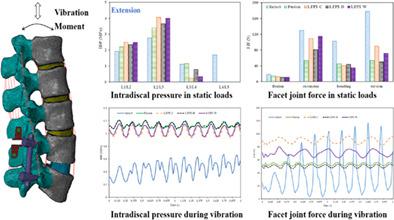当前位置:
X-MOL 学术
›
Int. J. Numer. Method. Biomed. Eng.
›
论文详情
Our official English website, www.x-mol.net, welcomes your
feedback! (Note: you will need to create a separate account there.)
Biomechanical analysis of lumbar fusion with proximal interspinous process device implantation
International Journal for Numerical Methods in Biomedical Engineering ( IF 2.2 ) Pub Date : 2021-05-17 , DOI: 10.1002/cnm.3498 Hangkai Shen 1, 2 , Guy R Fogel 3 , Jia Zhu 2 , Zhenhua Liao 2 , Weiqiang Liu 1, 2
International Journal for Numerical Methods in Biomedical Engineering ( IF 2.2 ) Pub Date : 2021-05-17 , DOI: 10.1002/cnm.3498 Hangkai Shen 1, 2 , Guy R Fogel 3 , Jia Zhu 2 , Zhenhua Liao 2 , Weiqiang Liu 1, 2
Affiliation

|
Lumbar spinal fusion may cause adjacent segment degeneration (ASD) in the long term. Recently, inserting an interspinous process device (IPD) proximal to the fusion has been proposed to prevent ASD. The aim of this study was to investigate the biomechanics of lumbar fusion with proximal IPD implantation (LFPI) under both static loads and whole body vibration (WBV). A previously validated finite element (FE) model of the L1-5 lumbar spine was modified to simulate L4-5 fusion. Three different IPDs (Coflex-F, Wallis and DIAM) were inserted at the L3-4 segment of the fusion model to construct the LFPI models. The intact and surgical FE models were analyzed under static loads and WBV, respectively. Under static loading conditions, LFPI decreased range of motion (ROM) and intradiscal pressure (IDP) at the transition segment L3-4 compared with the fusion case. At the segment (L2-3) adjacent to the transition level, LFPI induced higher motion and IDP than rigid fusion. Under WBV, vibration amplitudes of the L3-4 IDP and L4-5 facet joint force (FJF) decreased by more than 54.3% after surgery. The LFPI model with the DIAM system offered the most comparable biomechanics to the intact model under static loads, and decreased the dynamic responses of the L4-5 FJF under WBV. The LFPI model with the Wallis and Coflex-F systems could stabilize the transition segment, and decrease dynamic responses of the L3-4 IDP. The DIAM system may be more suitable in LFPI.
中文翻译:

近端棘突间装置植入腰椎融合的生物力学分析
从长远来看,腰椎融合可能会导致相邻节段退变(ASD)。最近,有人提议在融合处附近插入棘突间装置 (IPD) 来预防 ASD。本研究的目的是研究在静态载荷和全身振动 (WBV) 下近端 IPD 植入 (LFPI) 腰椎融合的生物力学。先前验证的 L1-5 腰椎有限元 (FE) 模型被修改为模拟 L4-5 融合。在融合模型的 L3-4 段插入三种不同的 IPD(Coflex-F、Wallis 和 DIAM)以构建 LFPI 模型。分别在静态载荷和 WBV 下分析完整和手术 FE 模型。在静载荷条件下,与融合病例相比,LFPI 降低了过渡段 L3-4 的运动范围 (ROM) 和椎间盘内压力 (IDP)。在与过渡水平相邻的节段 (L2-3) 处,LFPI 比刚性融合引起更高的运动和 IDP。在 WBV 下,L3-4 IDP 和 L4-5 小关节力 (FJF) 的振动幅度在手术后下降了 54.3% 以上。带有 DIAM 系统的 LFPI 模型在静态载荷下提供了与完整模型最具可比性的生物力学,并降低了 L4-5 FJF 在 WBV 下的动态响应。带有 Wallis 和 Coflex-F 系统的 LFPI 模型可以稳定过渡段,并降低 L3-4 IDP 的动态响应。DIAM 系统可能更适合 LFPI。手术后 L3-4 IDP 和 L4-5 小关节力 (FJF) 的振动幅度降低了 54.3% 以上。带有 DIAM 系统的 LFPI 模型在静态载荷下提供了与完整模型最具可比性的生物力学,并降低了 L4-5 FJF 在 WBV 下的动态响应。带有 Wallis 和 Coflex-F 系统的 LFPI 模型可以稳定过渡段,并降低 L3-4 IDP 的动态响应。DIAM 系统可能更适合 LFPI。手术后 L3-4 IDP 和 L4-5 小关节力 (FJF) 的振动幅度降低了 54.3% 以上。带有 DIAM 系统的 LFPI 模型在静态载荷下提供了与完整模型最具可比性的生物力学,并降低了 L4-5 FJF 在 WBV 下的动态响应。带有 Wallis 和 Coflex-F 系统的 LFPI 模型可以稳定过渡段,并降低 L3-4 IDP 的动态响应。DIAM 系统可能更适合 LFPI。带有 Wallis 和 Coflex-F 系统的 LFPI 模型可以稳定过渡段,并降低 L3-4 IDP 的动态响应。DIAM 系统可能更适合 LFPI。带有 Wallis 和 Coflex-F 系统的 LFPI 模型可以稳定过渡段,并降低 L3-4 IDP 的动态响应。DIAM 系统可能更适合 LFPI。
更新日期:2021-05-17
中文翻译:

近端棘突间装置植入腰椎融合的生物力学分析
从长远来看,腰椎融合可能会导致相邻节段退变(ASD)。最近,有人提议在融合处附近插入棘突间装置 (IPD) 来预防 ASD。本研究的目的是研究在静态载荷和全身振动 (WBV) 下近端 IPD 植入 (LFPI) 腰椎融合的生物力学。先前验证的 L1-5 腰椎有限元 (FE) 模型被修改为模拟 L4-5 融合。在融合模型的 L3-4 段插入三种不同的 IPD(Coflex-F、Wallis 和 DIAM)以构建 LFPI 模型。分别在静态载荷和 WBV 下分析完整和手术 FE 模型。在静载荷条件下,与融合病例相比,LFPI 降低了过渡段 L3-4 的运动范围 (ROM) 和椎间盘内压力 (IDP)。在与过渡水平相邻的节段 (L2-3) 处,LFPI 比刚性融合引起更高的运动和 IDP。在 WBV 下,L3-4 IDP 和 L4-5 小关节力 (FJF) 的振动幅度在手术后下降了 54.3% 以上。带有 DIAM 系统的 LFPI 模型在静态载荷下提供了与完整模型最具可比性的生物力学,并降低了 L4-5 FJF 在 WBV 下的动态响应。带有 Wallis 和 Coflex-F 系统的 LFPI 模型可以稳定过渡段,并降低 L3-4 IDP 的动态响应。DIAM 系统可能更适合 LFPI。手术后 L3-4 IDP 和 L4-5 小关节力 (FJF) 的振动幅度降低了 54.3% 以上。带有 DIAM 系统的 LFPI 模型在静态载荷下提供了与完整模型最具可比性的生物力学,并降低了 L4-5 FJF 在 WBV 下的动态响应。带有 Wallis 和 Coflex-F 系统的 LFPI 模型可以稳定过渡段,并降低 L3-4 IDP 的动态响应。DIAM 系统可能更适合 LFPI。手术后 L3-4 IDP 和 L4-5 小关节力 (FJF) 的振动幅度降低了 54.3% 以上。带有 DIAM 系统的 LFPI 模型在静态载荷下提供了与完整模型最具可比性的生物力学,并降低了 L4-5 FJF 在 WBV 下的动态响应。带有 Wallis 和 Coflex-F 系统的 LFPI 模型可以稳定过渡段,并降低 L3-4 IDP 的动态响应。DIAM 系统可能更适合 LFPI。带有 Wallis 和 Coflex-F 系统的 LFPI 模型可以稳定过渡段,并降低 L3-4 IDP 的动态响应。DIAM 系统可能更适合 LFPI。带有 Wallis 和 Coflex-F 系统的 LFPI 模型可以稳定过渡段,并降低 L3-4 IDP 的动态响应。DIAM 系统可能更适合 LFPI。











































 京公网安备 11010802027423号
京公网安备 11010802027423号